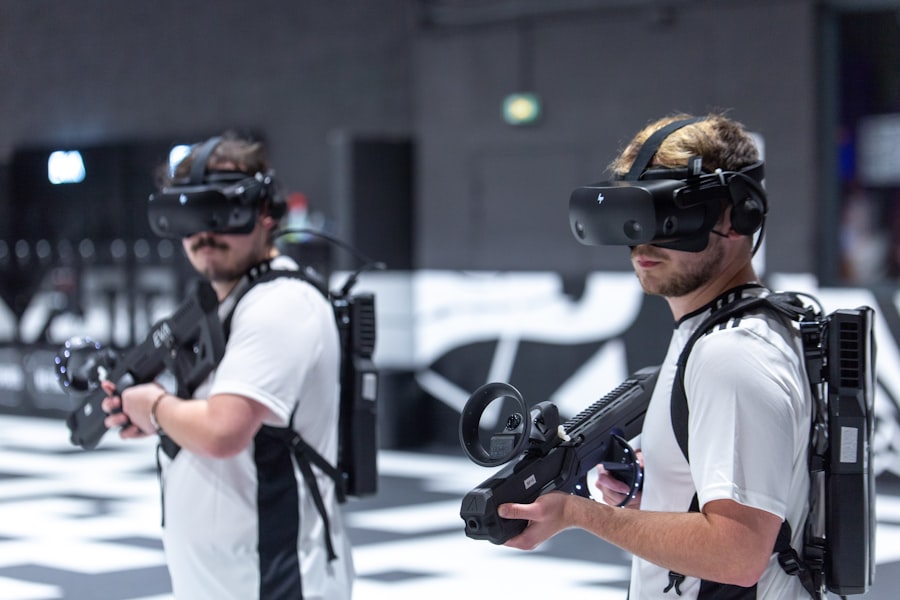Valve Corporation, a titan in the gaming industry, has made significant strides in the development of its own metaverse, a digital universe that transcends traditional gaming experiences. This evolution is not merely a response to the growing interest in virtual environments but a strategic move to redefine how players interact with games and each other. Valve’s foray into the metaverse is marked by its innovative approach to integrating gaming, social interaction, and user-generated content, creating a multifaceted platform that appeals to a diverse audience.
The rise of Valve’s metaverse can be traced back to its successful franchises, such as “Half-Life,” “Dota 2,” and “Counter-Strike.” These games have not only garnered massive player bases but have also fostered vibrant communities. Valve’s commitment to enhancing these communities through immersive experiences is evident in its development of virtual reality (VR) technologies and platforms like SteamVR. By leveraging its existing infrastructure and user engagement, Valve is poised to create a metaverse that is both expansive and deeply interconnected, allowing players to traverse various game worlds while maintaining a sense of continuity and community.
Key Takeaways
- Valve’s Metaverse is on the rise, offering a new virtual landscape for users to explore and interact in.
- Virtual reality has the potential to revolutionize the way we engage with Valve’s Metaverse, offering immersive experiences and endless possibilities.
- Navigating Valve’s Metaverse requires users to adapt to a new virtual landscape, with unique challenges and opportunities for exploration.
- Valve’s Metaverse has the potential to impact social interaction, offering new ways for users to connect and engage with others in a virtual space.
- Gaming plays a significant role in Valve’s Metaverse, offering users the opportunity to engage in immersive experiences and create new virtual worlds.
The Potential of Virtual Reality in the Metaverse
Enhancing Emotional Engagement and Realism
With VR headsets becoming increasingly accessible and advanced, players can step into their favorite games, experiencing them from a first-person perspective that enhances emotional engagement and realism. This level of immersion transforms gameplay from a passive activity into an active exploration of virtual worlds.
Fostering Social Interaction and Community Building
VR technology enables new forms of social interaction within the metaverse. Players can meet in virtual spaces, attend events, or collaborate on projects in real-time, fostering a sense of presence that transcends geographical boundaries. For instance, Valve’s integration of VR into its metaverse could allow players to participate in virtual concerts or esports tournaments, where they can interact with others as if they were physically present.
This potential for social connectivity is one of the most compelling aspects of VR in the metaverse, as it creates opportunities for shared experiences that can strengthen community bonds.

Navigating the virtual landscape of Valve’s metaverse presents both challenges and opportunities for users. The design of this digital universe is likely to be complex, with various interconnected environments that reflect the diverse genres and themes of Valve’s games. Players will need to familiarize themselves with the mechanics of movement and interaction within these spaces, which may differ significantly from traditional gaming controls.
This learning curve could be daunting for some, but it also offers an exciting opportunity for exploration and discovery.
From engaging in competitive matches in “Dota 2” arenas to exploring the narrative-rich environments of “Half-Life,” the possibilities are virtually limitless.
Additionally, Valve’s emphasis on user-generated content means that players can contribute to the landscape themselves, creating custom maps, game modes, or even entirely new experiences that enrich the metaverse. This collaborative aspect not only enhances player agency but also fosters a sense of ownership over the virtual world.
The Impact of Valve’s Metaverse on Social Interaction
| Metrics | Data |
|---|---|
| Number of active users | Millions |
| Time spent in the metaverse | Hours per day |
| Virtual goods transactions | Billions of dollars |
| Social interactions per user | Per day |
| Impact on mental health | Studies and surveys |
The impact of Valve’s metaverse on social interaction is profound, as it redefines how individuals connect and communicate within digital spaces. Traditional gaming often involves isolated experiences or limited interactions through text or voice chat. In contrast, Valve’s metaverse aims to create a more immersive social environment where players can engage with one another in real-time, using avatars to represent themselves in shared spaces.
This shift towards more dynamic interactions can lead to deeper connections among players, as they navigate challenges together or simply enjoy each other’s company in virtual lounges. Furthermore, the metaverse has the potential to break down barriers that often exist in physical spaces. Players from different backgrounds and locations can come together without the constraints of distance or social norms that may inhibit interaction in real life.
This inclusivity fosters a diverse community where individuals can share their experiences and perspectives, enriching the overall culture of the metaverse. As players collaborate on projects or participate in events, they build relationships that extend beyond the confines of individual games, creating a sense of belonging within a larger digital society.
The Role of Gaming in Valve’s Metaverse
Gaming serves as the cornerstone of Valve’s metaverse, providing the foundation upon which this expansive digital universe is built. The integration of gaming into the metaverse allows for a seamless blend of entertainment and social interaction, where players can engage with their favorite titles while exploring new dimensions of connectivity. Valve’s extensive library of games offers a diverse range of experiences that cater to various interests and play styles, ensuring that there is something for everyone within this virtual realm.
Moreover, gaming within the metaverse encourages innovation and creativity among players. As they engage with existing titles or create their own content, users are empowered to experiment with gameplay mechanics and storytelling techniques. This creative freedom not only enhances individual experiences but also contributes to the evolution of gaming as a whole.
For instance, players might develop new game modes that incorporate elements from multiple genres or create narrative-driven experiences that challenge conventional storytelling methods. In this way, gaming becomes a dynamic force within Valve’s metaverse, driving engagement and inspiring collaboration among its users.
Creating and Customizing Avatars in Valve’s Metaverse

A key feature of Valve’s metaverse is the ability for players to create and customize their avatars, which serve as their digital representations within this expansive universe. The process of avatar creation is not merely about aesthetics; it allows players to express their identities and personalities in ways that resonate with their gaming experiences. From selecting physical attributes to choosing clothing and accessories, avatar customization offers a unique opportunity for self-expression that enhances immersion in the virtual world.
The significance of avatar customization extends beyond personal expression; it also plays a crucial role in social interactions within the metaverse. Avatars become a means through which players communicate non-verbally, conveying emotions and intentions through body language and visual cues. For example, a player might choose an avatar with exaggerated features or vibrant colors to stand out in a crowd or select more subdued attire to blend into specific environments.
This visual language fosters connections among players as they navigate shared spaces, creating an environment where individuality is celebrated while still promoting community engagement.
Exploring Virtual Economies and Marketplaces in Valve’s Metaverse
The emergence of virtual economies within Valve’s metaverse presents exciting opportunities for players to engage in commerce and trade. These economies are likely to be built around user-generated content, where players can create items, skins, or even entire game modes that can be bought or sold within the marketplace. This system not only incentivizes creativity but also allows players to monetize their contributions to the metaverse, fostering a sense of entrepreneurship among users.
Valve’s established infrastructure through platforms like Steam provides a solid foundation for these virtual economies. Players can utilize existing payment systems and trade mechanisms to facilitate transactions seamlessly. Moreover, the integration of blockchain technology could further enhance security and transparency within these marketplaces, allowing users to verify ownership and authenticity of digital assets.
As players engage in buying and selling activities, they contribute to a vibrant economic ecosystem that mirrors real-world markets while offering unique opportunities for innovation and collaboration.
The Future of Valve’s Metaverse and its Implications for Society
Looking ahead, the future of Valve’s metaverse holds significant implications for society at large. As digital spaces become increasingly integrated into daily life, the boundaries between virtual and physical realities may blur further. This evolution could lead to new forms of social interaction, entertainment consumption, and even economic activity that challenge traditional norms.
For instance, as more individuals engage with virtual environments for work or leisure, there may be shifts in how we perceive community and connection. Additionally, Valve’s metaverse could serve as a testing ground for emerging technologies such as artificial intelligence and machine learning. These advancements could enhance user experiences by personalizing interactions or creating dynamic environments that respond to player behavior in real-time.
As these technologies evolve alongside the metaverse, they may reshape our understanding of agency and autonomy within digital spaces. In conclusion, Valve’s metaverse represents a bold step into an uncharted digital frontier where gaming, social interaction, and economic activity converge. As this virtual universe continues to develop, it will undoubtedly influence how we connect with one another and engage with technology in profound ways.
The implications for society are vast, offering both challenges and opportunities as we navigate this new landscape together.
If you’re interested in exploring how virtual environments are being developed and utilized, particularly in the context of Valve’s involvement in the metaverse, you might find the article “Entering the Metaverse: Exploring Virtual Spaces” insightful. It delves into the various aspects of virtual spaces, including how companies like Valve are contributing to these digital realms. For a deeper understanding, you can read the full article here.
FAQs
What is Valve’s Metaverse?
Valve’s Metaverse is a virtual reality platform being developed by the video game company Valve Corporation. It aims to create a shared, persistent virtual environment that can be accessed by users from around the world.
What is the purpose of Valve’s Metaverse?
Valve’s Metaverse is being designed to provide a platform for social interaction, gaming, and other virtual experiences. It aims to create a seamless and immersive virtual environment where users can interact with each other and with digital content.
How does Valve’s Metaverse differ from other virtual reality platforms?
Valve’s Metaverse is aiming to differentiate itself by focusing on creating a more open and interconnected virtual environment. It aims to allow users to seamlessly move between different virtual spaces and experiences, creating a more cohesive and immersive virtual world.
When will Valve’s Metaverse be available to the public?
Valve has not announced a specific release date for its Metaverse platform. Development is ongoing, and the company has not provided a timeline for when the platform will be available to the public.
What kind of experiences can users expect in Valve’s Metaverse?
Valve’s Metaverse is expected to offer a wide range of experiences, including social interactions, gaming, virtual events, and digital content creation. The platform aims to provide a diverse and immersive virtual environment for users to explore and engage with.

Leave a Reply